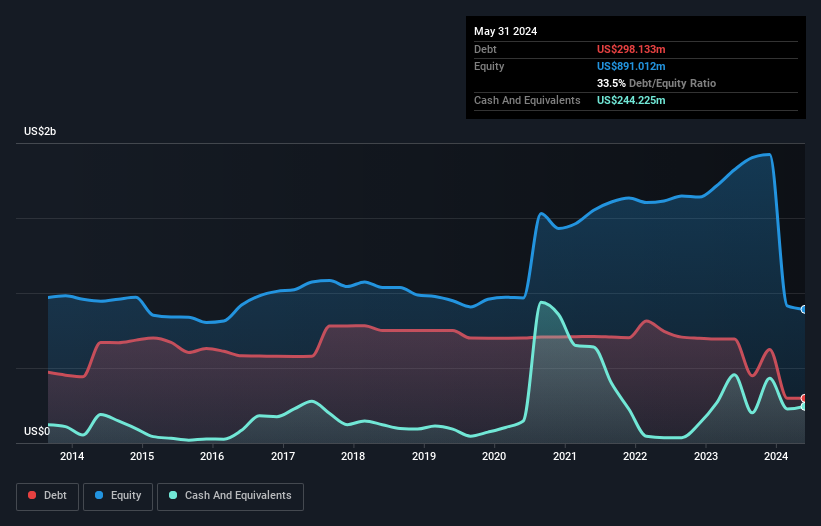David Iben put it well when he said, 'Volatility is not a risk we care about. What we care about is avoiding the permanent loss of capital.' So it seems the smart money knows that debt - which is usually involved in bankruptcies - is a very important factor, when you assess how risky a company is. As with many other companies Worthington Enterprises, Inc. (NYSE:WOR) makes use of debt. But the real question is whether this debt is making the company risky.
When Is Debt Dangerous?
Debt and other liabilities become risky for a business when it cannot easily fulfill those obligations, either with free cash flow or by raising capital at an attractive price. Part and parcel of capitalism is the process of 'creative destruction' where failed businesses are mercilessly liquidated by their bankers. However, a more usual (but still expensive) situation is where a company must dilute shareholders at a cheap share price simply to get debt under control. By replacing dilution, though, debt can be an extremely good tool for businesses that need capital to invest in growth at high rates of return. When we think about a company's use of debt, we first look at cash and debt together.
Check out our latest analysis for Worthington Enterprises
What Is Worthington Enterprises's Debt?
The image below, which you can click on for greater detail, shows that Worthington Enterprises had debt of US$298.1m at the end of May 2024, a reduction from US$692.8m over a year. However, because it has a cash reserve of US$244.2m, its net debt is less, at about US$53.9m.

A Look At Worthington Enterprises' Liabilities
According to the last reported balance sheet, Worthington Enterprises had liabilities of US$178.4m due within 12 months, and liabilities of US$569.2m due beyond 12 months. Offsetting these obligations, it had cash of US$244.2m as well as receivables valued at US$217.1m due within 12 months. So its liabilities total US$286.3m more than the combination of its cash and short-term receivables.
Of course, Worthington Enterprises has a market capitalization of US$2.52b, so these liabilities are probably manageable. But there are sufficient liabilities that we would certainly recommend shareholders continue to monitor the balance sheet, going forward.
We measure a company's debt load relative to its earnings power by looking at its net debt divided by its earnings before interest, tax, depreciation, and amortization (EBITDA) and by calculating how easily its earnings before interest and tax (EBIT) cover its interest expense (interest cover). This way, we consider both the absolute quantum of the debt, as well as the interest rates paid on it.
Worthington Enterprises has a very low debt to EBITDA ratio of 0.66 so it is strange to see weak interest coverage, with last year's EBIT being only 0.98 times the interest expense. So one way or the other, it's clear the debt levels are not trivial. Importantly, Worthington Enterprises's EBIT fell a jaw-dropping 99% in the last twelve months. If that earnings trend continues then paying off its debt will be about as easy as herding cats on to a roller coaster. The balance sheet is clearly the area to focus on when you are analysing debt. But it is future earnings, more than anything, that will determine Worthington Enterprises's ability to maintain a healthy balance sheet going forward. So if you're focused on the future you can check out this free report showing analyst profit forecasts.
Finally, a business needs free cash flow to pay off debt; accounting profits just don't cut it. So the logical step is to look at the proportion of that EBIT that is matched by actual free cash flow. Over the last three years, Worthington Enterprises actually produced more free cash flow than EBIT. That sort of strong cash conversion gets us as excited as the crowd when the beat drops at a Daft Punk concert.
Our View
Worthington Enterprises's EBIT growth rate was a real negative on this analysis, as was its interest cover. But its conversion of EBIT to free cash flow was significantly redeeming. Looking at all this data makes us feel a little cautious about Worthington Enterprises's debt levels. While we appreciate debt can enhance returns on equity, we'd suggest that shareholders keep close watch on its debt levels, lest they increase. The balance sheet is clearly the area to focus on when you are analysing debt. But ultimately, every company can contain risks that exist outside of the balance sheet. For example - Worthington Enterprises has 3 warning signs we think you should be aware of.
Of course, if you're the type of investor who prefers buying stocks without the burden of debt, then don't hesitate to discover our exclusive list of net cash growth stocks, today.
Valuation is complex, but we're here to simplify it.
Discover if Worthington Enterprises might be undervalued or overvalued with our detailed analysis, featuring fair value estimates, potential risks, dividends, insider trades, and its financial condition.
Access Free AnalysisHave feedback on this article? Concerned about the content? Get in touch with us directly. Alternatively, email editorial-team (at) simplywallst.com.
This article by Simply Wall St is general in nature. We provide commentary based on historical data and analyst forecasts only using an unbiased methodology and our articles are not intended to be financial advice. It does not constitute a recommendation to buy or sell any stock, and does not take account of your objectives, or your financial situation. We aim to bring you long-term focused analysis driven by fundamental data. Note that our analysis may not factor in the latest price-sensitive company announcements or qualitative material. Simply Wall St has no position in any stocks mentioned.
Have feedback on this article? Concerned about the content? Get in touch with us directly. Alternatively, email editorial-team@simplywallst.com
About NYSE:WOR
Flawless balance sheet and fair value.
Similar Companies
Market Insights
Community Narratives




